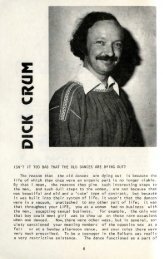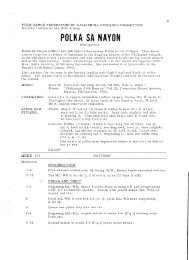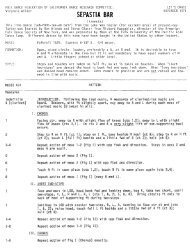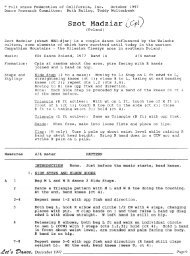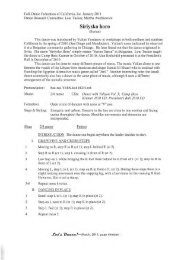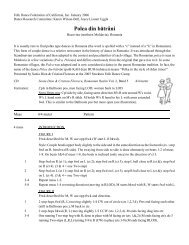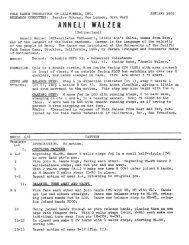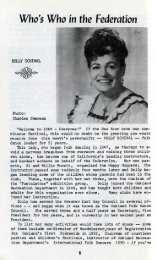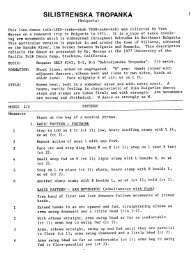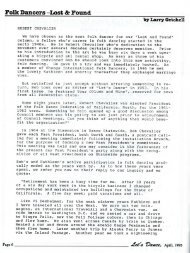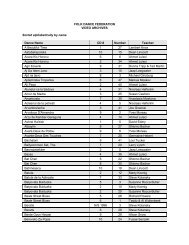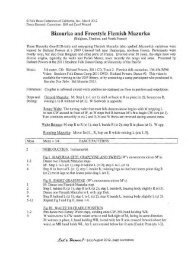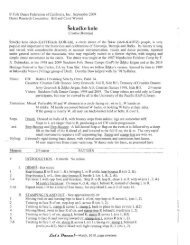Argo Hasapiko - Folk Dance Federation of California
Argo Hasapiko - Folk Dance Federation of California
Argo Hasapiko - Folk Dance Federation of California
You also want an ePaper? Increase the reach of your titles
YUMPU automatically turns print PDFs into web optimized ePapers that Google loves.
FOlK DANCE FEDERATION OF CALIFORNIA RESEARCH COMMITTEE:<br />
Bernice Schram<br />
ARGO HASAPI KO<br />
(Greece)<br />
LET'S DANCE<br />
February 1970<br />
The lIasapiko was originally danced by the butchers <strong>of</strong> Constantinople and has always been a dance<br />
<strong>of</strong> the cities rather than the mountains or rural areas. <strong>Argo</strong> lIasapiko (slow <strong>Hasapiko</strong>) is also known<br />
as Vari <strong>Hasapiko</strong> (heo.V'JlIasapiko). Peiraiotiko <strong>Hasapiko</strong> (<strong>Hasapiko</strong> from Peiraius. the seaport <strong>of</strong><br />
Athens). Naftiko <strong>Hasapiko</strong> (sailor's lIasapiko). or Just <strong>Hasapiko</strong>. <strong>Argo</strong> <strong>Hasapiko</strong> (Ahr-GOH Hah-SAH-peekohl<br />
is a slow form <strong>of</strong> the lIasapiko family <strong>of</strong> dances. The Syrtaki starts with <strong>Argo</strong> <strong>Hasapiko</strong> and then<br />
speeds up to Hasaposerviko or a fast tempo <strong>Hasapiko</strong>.<br />
Tradi tionally the dance io a very "personal" one -- not social in nature. In a Greek taverna it<br />
would be done only by close friends in a very small group. A stranger would never Join such a line.<br />
The background. styling and variations included in this description were presented at the University<br />
a; <strong>of</strong> the Pacific <strong>Folk</strong> <strong>Dance</strong> Camp. Stockton. <strong>California</strong>. in 1969. by John Pappas. who had observed and<br />
performed the dance both in <strong>California</strong> and in Greece and found no difference in the style.<br />
MUSIC:<br />
FORMATION:<br />
Records: Nina 4510-A, Odyssey 1101. Alootor 5004. There are numerous melodies in<br />
Slow <strong>Hasapiko</strong> style and many good recordings other than the ones listed.<br />
Short lines <strong>of</strong> dancers facing the ctr <strong>of</strong> the dancing area - usually from 3 to 5 in a<br />
line - with the leader at the R end. Although originally danced by M only. W now Join<br />
in the dance and mixed lines are permissible. Leader and dancer at L end <strong>of</strong> line<br />
extend free hand to side at shoulder height. arm fairly straight. Emphasize rhythm by<br />
snapping fingers. Free hand may be at waist instead with fingers fWd. A shoulder hold<br />
is always used. even if only one M and one Ware dancing. Extend arms out to side and<br />
rest hands on near shoulder <strong>of</strong> dancer at each side. Avoid allowing the hands to slip<br />
down to the upper arm. An alternate position is to allow the extended arms to reach<br />
across in back <strong>of</strong> neighbors. resting hands on the far shoulder <strong>of</strong> dancer at each side.<br />
STEPS AND A few basic step patterns are included in this description. and various combinations<br />
STYLING: and modifications <strong>of</strong> these will give the average folk dancer a background for leading<br />
or following. There are many other variations. The dance has no set pattern. The<br />
."__'<br />
figures are danced as selected by the leader. lie leads by contact and not by<br />
-F~r~1ll.s~rea,sqn t.~~_lin~_s must _be short._ JE..Ilo~J2-ULl!J.~ne~J:_~ alrea.~has<br />
calls •<br />
4 dancers. -~~<br />
Several types <strong>of</strong> styling are appropriate to the dance. depending upon the leader. Some<br />
dance with very erect posture and a slight flex <strong>of</strong> the knees. Others dance bent slightly<br />
fWd from the waist and with more flex in the knees. This is one <strong>of</strong> the few Greek dances<br />
in which the dancers look down at the floor. The feeling is cat-like and sinewy.<br />
MUSIC 2/4 or 4/4 (slow tempo)<br />
Measures<br />
2/4 I. "BASIC" VARIATION "A"<br />
1<br />
2<br />
3<br />
4<br />
PATTERN<br />
Lunge fWd on L ft (ct 1). bring R ft around to the front <strong>of</strong> L. keeping it close to L<br />
leg as you move it (ct &). touch R ft to floor directly in front <strong>of</strong> and close to L<br />
(no wt) (ct 2). bring R ft around to back <strong>of</strong> L. keeping it close to L leg as you move<br />
it (ct &).<br />
Step on R ft directly behind L, R toe touching L heel (ct 1), bring L ft around behind<br />
R (ct &), step on L ft directly behind R. L toe touching R heel (ct 2), bring R ft<br />
sdwd to the R (ct &).<br />
Step on R (ct 1), step fWd on L (ct &). step bkwd on R (ct 2), draw L ft back in front<br />
<strong>of</strong> R, outside <strong>of</strong> L ankle across R instep (ct &).<br />
Touch L heel to floor diag fWd and L, knee straight (ct 1). lift L heel a little from<br />
the floor, bending L knee (ct &), repeat action <strong>of</strong> cts 1-&, meas 4 (cts 2-&) ~ touch<br />
L toe to floor to R <strong>of</strong> R toe, L knee bent (ct 2), hold (ct &).<br />
NOTE: This variation may also be danced as a 6-ct pattern, in which case meas I, 2 and<br />
3 are danced twice in succession. followed by any 4-ct pattern to coincide with the<br />
usual 8-ct musical phrase. The good leader evolves patterns which fit the phrasing <strong>of</strong><br />
the music used.<br />
II. VARIATION "B"<br />
1-3 Repeat al'tion <strong>of</strong> Basic Variation "A" meas 1-3 through ct 2 <strong>of</strong> meas 3, bring L ft around
ARGO HASAPIKO (continued)<br />
behind R ft (ct &).<br />
4 Step on L directly behind R ft (ct 1). bring R around behind L ft (ct &), step on R<br />
behind L (ct 2), slightly lift L ft from ground across in front <strong>of</strong> Rankle (ct &).<br />
III. VARIATION "e"<br />
1 Step on L ft across in front <strong>of</strong> R (ct 1), step on R sdwd to the R (ct &), step on L<br />
across in front <strong>of</strong> R (ct 2), bring H all the way around to the front and across L ft,<br />
keeping R ft close to L leg (ct &).<br />
2 ~ltep on R across in front <strong>of</strong> L (ct 1), step on L sdwd to the L (ct &), step on R<br />
across in front <strong>of</strong> L (ct 2), pause slightly, liftinp, L leg, which is close behind R<br />
(ct &).<br />
3 Step on L directly behind R .and close to it (ct 1), bring R ft around and behind L<br />
(ct &), step on R behind L (ct 2), draw L ft back in front <strong>of</strong> R, outside <strong>of</strong> L ankle<br />
across R instep (ct &).<br />
4 Repeat action <strong>of</strong> meas 4, Variation "A".<br />
IV. VARIATION "D"<br />
1 Step sdwd to Lon L (ct 1), draw R ft to L (ct &), touch R to floor next to L (no wt)<br />
(ct 2), move R ft sdwd to the R (ct &).<br />
2 Step on R (ct 1), draw L ft to R (ct &), touch L ft to floor next to R (no wt) (ct 2),<br />
pau~e (ct &).<br />
_________ Y.J_VMUATION ••~_" __ 0<br />
NOTE: This variation may be repeated to make an 8-ct figure, or it may be used as<br />
meas 1-2 or as meas 3-4 in other variations.<br />
••• • ~ --.--~~r_----<br />
---<br />
1 Step on L across in front <strong>of</strong> R (ct 1), step on R sdwd to R (ct &), step on L in back<br />
<strong>of</strong> R (ct 2), step on R sdwd to R (ct &).<br />
2 Step on L across in front <strong>of</strong> R (ct 1), bring R ft fwd in a small, low arc aridacross<br />
in front <strong>of</strong> L (ct &), step on R across in front <strong>of</strong> L (ct 2), step on L sdwd to L (ct.&).<br />
3 Step on R in back <strong>of</strong> L (ct 1), step on L sdwd to L (ct &), step on R across in front<br />
<strong>of</strong> L (ct 2), move L ft to L (ct &).<br />
4 Step on L (ct 1), bring ~ ft to L (ct &), step on R next to L (ct 2), pause (ct &).<br />
VI. VARIATION "F"<br />
1-2 Repeat action <strong>of</strong> meas 1-2, Basic Variation "A".<br />
3 Step on R across in front <strong>of</strong> L (ct 1), step sdwd to Lon L (ct &), step on R across in<br />
front <strong>of</strong> L (ct 2), bring L ft fwd in a small arc and across in front <strong>of</strong> R (ct &).<br />
4 Step on L in front <strong>of</strong> R, bending fwd at the waist and lifting the straight R leg behind<br />
you (cts 1-&), straighten body and step on R behind and to L <strong>of</strong> L ft (ct 2), pause<br />
(ct &).<br />
VII. VARIATION "G"<br />
1 From a pos with ft together and parallel move toes apart (heels pivot, remaining<br />
together) (ct 1-&), move heels apart so that ft are parallel (not pigeon-toed) as toes<br />
pivot in place (cts 2-&).<br />
2 Move heels together as toes pivot in place (cts 1-&), move toes together as heels pivot<br />
(cts 2-&). Ft are now together and parallel.<br />
VIII. VARIATION "H"<br />
1 Lunge fwd on L (ct 1), close R ft to L, bringing it behind and to L 0 f L ft (ct &),
-en<br />
ARGOHASAPIKO(continued)<br />
step fWd on L, bending body slightly fWd at waist (ct 2), slight pause (ct Bo).<br />
2-4 Repeat action <strong>of</strong> meas 2-4, Variation "A" or "B".<br />
.- .•..<br />
,...~.~' ..-. ~-<br />
... :,..,.......<br />
.... 0' __ ,~_ •.<br />
.~<br />
I<br />
• I



